Machinery in a dairy factory plays a crucial role in processing milk and producing various dairy products efficiently and safely. These machines are designed to handle large volumes of milk, maintain hygiene standards, and ensure consistent product quality. Here is an overview of some key machinery used in dairy factories:
- Pasteurizers: Pasteurizers are essential for killing harmful bacteria in raw milk. They heat the milk to a specific temperature for a set period, ensuring it is safe for consumption. There are different types of pasteurizers, including batch pasteurizers and continuous flow pasteurizers, each suited for different production scales.
- Homogenizers: Homogenizers are used to break down fat molecules in milk, ensuring a uniform and smooth texture. This process prevents cream from separating and rising to the top. Homogenization enhances the quality and shelf life of milk and other dairy products.
- Centrifuges: Centrifuges separate cream from milk. By spinning at high speeds, they use centrifugal force to divide the denser cream from the lighter milk. The cream can then be processed into products like butter and heavy cream, while the skimmed milk can be used for low-fat dairy products.
- Cheese Vats and Presses: Cheese production involves curdling milk and separating the curds from the whey. Cheese vats are large tanks where milk is curdled using rennet and other enzymes. Once the curds form, they are cut, stirred, and heated. Presses are then used to squeeze out excess whey and shape the cheese into blocks or wheels.
- Yogurt Fermentation Tanks: These tanks are designed to maintain optimal conditions for the fermentation process. Milk is inoculated with bacterial cultures and kept at a specific temperature to develop yogurt. The tanks ensure consistent fermentation, resulting in uniform texture and flavor.
- Butter Churns: Butter churns are machines that agitate cream until the fat separates from the buttermilk, forming butter. Modern butter churns are automated and can handle large quantities of cream, producing butter efficiently.
- Packaging Machines: Once dairy products are processed, they need to be packaged for distribution. Automated packaging machines fill, seal, and label containers of various sizes. These machines maintain hygiene and prevent contamination, ensuring the products remain fresh.
- Refrigeration Units: Dairy products must be kept at low temperatures to prevent spoilage. Refrigeration units, including large industrial coolers and freezers, are crucial for storing raw milk, intermediate products, and finished goods.
- Quality Control Equipment: Ensuring the safety and quality of dairy products involves rigorous testing. Equipment such as microbiological analyzers, pH meters, and spectrometers are used to test for contaminants, monitor acidity levels, and verify the nutritional content of products.
- Cleaning Systems: Hygiene is paramount in dairy processing. Automated cleaning-in-place (CIP) systems clean and sanitize machinery and pipelines without disassembly. These systems ensure that equipment is free of residues and bacteria, maintaining high standards of cleanliness.
Conclusion
Machinery in a dairy factory is integral to the production of safe, high-quality dairy products. From pasteurization and homogenization to fermentation and packaging, each piece of equipment is designed to perform specific tasks efficiently. By leveraging advanced technology and maintaining stringent hygiene standards, dairy factories can meet the demands of consumers and ensure the consistent quality of their products.


